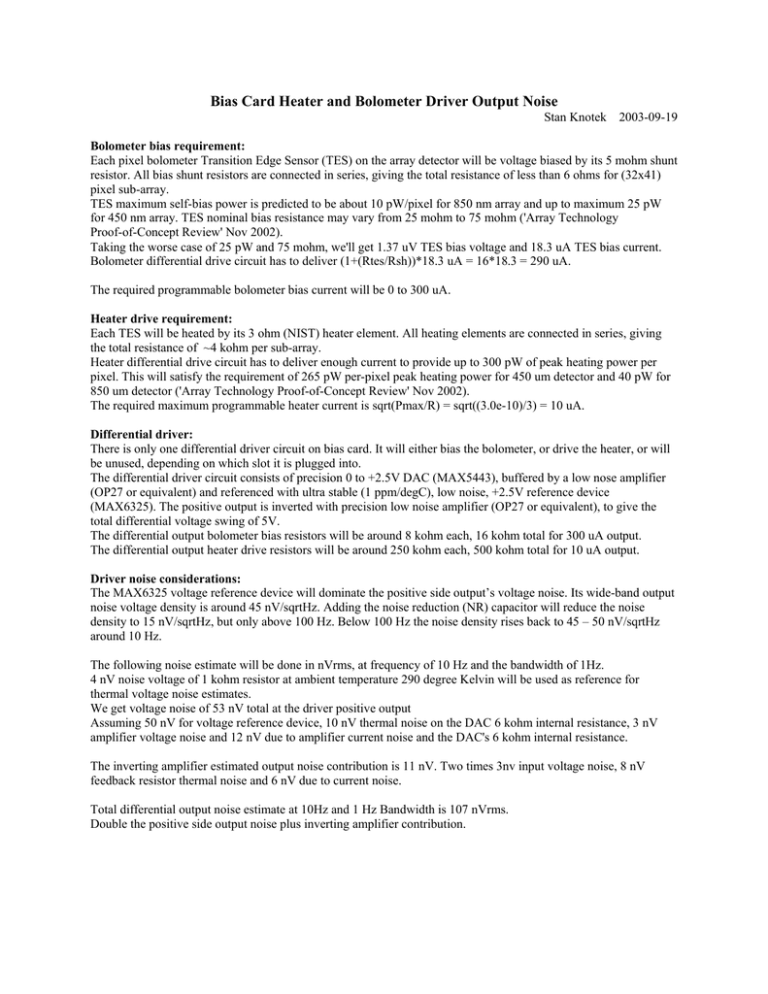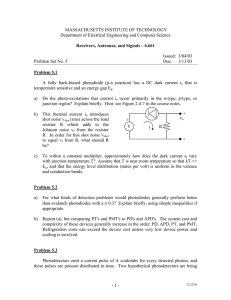Bias Card Outputs
advertisement

Bias Card Heater and Bolometer Driver Output Noise
Stan Knotek 2003-09-19
Bolometer bias requirement:
Each pixel bolometer Transition Edge Sensor (TES) on the array detector will be voltage biased by its 5 mohm shunt
resistor. All bias shunt resistors are connected in series, giving the total resistance of less than 6 ohms for (32x41)
pixel sub-array.
TES maximum self-bias power is predicted to be about 10 pW/pixel for 850 nm array and up to maximum 25 pW
for 450 nm array. TES nominal bias resistance may vary from 25 mohm to 75 mohm ('Array Technology
Proof-of-Concept Review' Nov 2002).
Taking the worse case of 25 pW and 75 mohm, we'll get 1.37 uV TES bias voltage and 18.3 uA TES bias current.
Bolometer differential drive circuit has to deliver (1+(Rtes/Rsh))*18.3 uA = 16*18.3 = 290 uA.
The required programmable bolometer bias current will be 0 to 300 uA.
Heater drive requirement:
Each TES will be heated by its 3 ohm (NIST) heater element. All heating elements are connected in series, giving
the total resistance of ~4 kohm per sub-array.
Heater differential drive circuit has to deliver enough current to provide up to 300 pW of peak heating power per
pixel. This will satisfy the requirement of 265 pW per-pixel peak heating power for 450 um detector and 40 pW for
850 um detector ('Array Technology Proof-of-Concept Review' Nov 2002).
The required maximum programmable heater current is sqrt(Pmax/R) = sqrt((3.0e-10)/3) = 10 uA.
Differential driver:
There is only one differential driver circuit on bias card. It will either bias the bolometer, or drive the heater, or will
be unused, depending on which slot it is plugged into.
The differential driver circuit consists of precision 0 to +2.5V DAC (MAX5443), buffered by a low nose amplifier
(OP27 or equivalent) and referenced with ultra stable (1 ppm/degC), low noise, +2.5V reference device
(MAX6325). The positive output is inverted with precision low noise amplifier (OP27 or equivalent), to give the
total differential voltage swing of 5V.
The differential output bolometer bias resistors will be around 8 kohm each, 16 kohm total for 300 uA output.
The differential output heater drive resistors will be around 250 kohm each, 500 kohm total for 10 uA output.
Driver noise considerations:
The MAX6325 voltage reference device will dominate the positive side output’s voltage noise. Its wide-band output
noise voltage density is around 45 nV/sqrtHz. Adding the noise reduction (NR) capacitor will reduce the noise
density to 15 nV/sqrtHz, but only above 100 Hz. Below 100 Hz the noise density rises back to 45 – 50 nV/sqrtHz
around 10 Hz.
The following noise estimate will be done in nVrms, at frequency of 10 Hz and the bandwidth of 1Hz.
4 nV noise voltage of 1 kohm resistor at ambient temperature 290 degree Kelvin will be used as reference for
thermal voltage noise estimates.
We get voltage noise of 53 nV total at the driver positive output
Assuming 50 nV for voltage reference device, 10 nV thermal noise on the DAC 6 kohm internal resistance, 3 nV
amplifier voltage noise and 12 nV due to amplifier current noise and the DAC's 6 kohm internal resistance.
The inverting amplifier estimated output noise contribution is 11 nV. Two times 3nv input voltage noise, 8 nV
feedback resistor thermal noise and 6 nV due to current noise.
Total differential output noise estimate at 10Hz and 1 Hz Bandwidth is 107 nVrms.
Double the positive side output noise plus inverting amplifier contribution.
Bias resistors and output current noise considerations:
The bolometer bias and heater bias resistors will be high quality metal film or bulk metal foil type. These resistors
have very low Temperature Coefficient of Resistance (TCR) and very low excess 1/f noise. Their excess
Noise Index (NI) is -40dB below 1uVrms/Vdc/decade, that is 10nVrms/Vdc/decade.
Excess 1/f noise voltage spectral density for these resistors is
Sn = (NI)/sqrt(ln10)f = (NI)/sqrt(2.303)f = 0.659(NI)/sqrt f = 6.59nVrms/Vdc/sqrt f
Excess noise density is then 33 nVrms/sqrt f at 5 Vdc bias
Bolometer bias resistors, 16 kohm total, have total thermal Johnson noise voltage (sqrt 16)*4 = 16 nVrms/Hz.
Excess 1/f noise at10 Hz is 33/sqrt10 = 11 nV/Hz.
Total resistor voltage noise is estimated at 109nVrms, which includes the 107 nV differential driver output noise,
16 nV resistor thermal noise and 11 nV resistor excess noise contributions.
Bolometer bias external noise current is then 109nV/16kohm = 6.8 pA rms/Hz.
The heating effect of this noise current on 5 mohm will be ~(5.0e-3)((6.8e-12)square) = 2.3e-25 W/Hz, not very
significant, when compared to per-pixel NEP of ~1.0e-17 W/Hz.
The bolometer bias circuit output noise current is divided between the bolometer shunt and the bolometer, where it
adds to the bolometer’s Johnson thermal noise.
The bolometer Johnson noise current will be derived at less favorable 25 mohm bias (25 to 75 mohm).
Bolometer and shunt resistance in series is 30 mohm, the temperature is ~100 mKelvin.
Bolometer Johnson thermal noise current is sqrt(4kT/R) = sqrt((4*(1.38e-23)*0.1/0.03)) = 13.5 pA rms/sqrtHz.
Only the 1/((Rbol/Rsh)+1) portion of the external noise current flows through the bolometer and is measured by the
first stage SQUID current sensor.
It is 6.8/((25/5)+1) = 6.8/6 = 1.1 pA rms/Hz, which is ~12 times lower then the bolometer’s Johnson noise current.
Heater bias resistors, 500 kohm total, have total thermal Johnson noise voltage (sqrt 500)*4 = 90 nVrms/Hz.
Total resistor voltage noise is estimated at 140nVrms, which includes the 107 nV differential driver output noise,
90 nV resistor thermal noise and 11 nV resistor excess noise.
Heater drive noise current is then 140nV/500kohm = 0.28pA rms/Hz.
The heating power of this noise current will be ~3((2.8e-13)square) = 2.4e-25 W, again not very significant, when
compared to per-pixel NEP of ~1.0e-17 W.
Conclusion:
The bolometer and heater current noise effects are much lower than the per-pixel NEP.
The fraction (~1/6 th) of bolometer bias current noise is coupled directly into the bolometer current sense loop and
could become a problem at frequencies below 10 Hz.
Justification for differential drive can be questioned. Doubling of the voltage swing does not improve noise
performance significantly at lover frequencies. Doubling the bias resistor and reducing its thermal noise by sqrt2
factor does not have serious effect, since the positive drive circuit noise dominates the overall performance.
Single ended positive drive would give good enough results.



